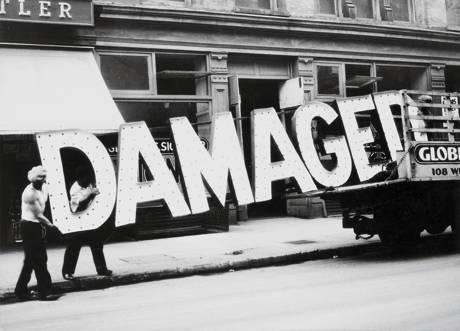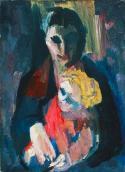Art Of The Day Weekly
#470 - from 27 April 2017 to 3 May 2017

Walker Evans, Truck and Sign, 1928-1930, vintage silver print, 16,5 x 22,2 cm. Private Collection, San Francisco © Walker Evans Archive, The Metropolitan Museum of Art Photo: © Fernando Maquieira, Cromotex
IN THE AIR
Walker Evans, another USA
PARIS – In our memories we immediately put him next to Dorothea Lange among the photographers who gave a testimonial of the economic crisis in the USA and the efforts of the New Deal to fight it. In this exhibition, the famous snapshots commissioned between 1935 and 1937 by the Farm Security Administration – the cotton farmers from Alabama, tight lipped and barefoot, with mended clothes – are very well placed. But the surprise is to see the extent of the matter dealt with during half a century by photographer Walker Evans (1903-1975), honoured here as the champion of vernacular (local architectures, shop front windows). What is most surprising are not these last Polaroid portraits churned out in great numbers, but rather his beginnings. In 1927, the young intellectual from Saint Louis saw himself as a writer. He studied French civilisation at the Sorbonne, read Huysmans, translated Baudelaire and Cendrars, acted like a Surrealist dandy by taking self-portraits in the automatic photo booths. His encounter with Berenice Abbott made him discover an empathy for the working class and the icons of materialistic civilisation. He then used one same documentary style that was very clean and frontal, to immortalise the USA of barns and hardware stores, of workers and car cemeteries, as well as the graphic abstraction of stainless steel tools or African masks – for the large exhibition at the MoMA in 1935. Evans was a sociologist as much as a photographer and had a passion for the subject of his studies. He was also a relentless collector and a huge quantity of daily objects were found in his home, from advertising posters to beer rings. A small part of this personal America crossed the Atlantic as well, next to the photographs.
• Walker Evans at the Centre Pompidou, from April 26 to August 14, 2017.
EXHIBITIONS
The Becher school
FRANCFORT - The couple of German photographers, Bernd (1931-2007) and Hilla Becher (1934-2015) developed a style that had quite a few similarities with that of Walker Evans: front images of objects not considered aesthetic - such as water towers or industrial chimneys - in a neutral light, without shadows nor distortions. They gave birth to a true current in their courses at the art school of Düsseldorf, and to some of today's best known and most highly priced photographers. Some 200 images by Thomas Ruff, Andreas Gursky or Candida Höfer prove the power of their influence.
• The Becher Class at Staedel Museum, from April 27 to August13, 2017

David Bomberg (1890-1957), The Artist’s Wife and Baby, 1937. Oil paint on canvas, 76.6 x 56.2 cm © Tate, London 2017
Men from London
MALAGA - A group of figurative painters from the post-war period have been grouped together under the generic and rather wide title of School of Paris. The same occurred in London around the emblematic figures of Bacon and Freud. The museum presents this School of London through ten artists, brought together through a shared questioning on the sense of painting and by strong friendships, developed in particular around the Marlborough gallery. Some of them are practically unknown to the public at large, such as David Bomberg and William Coldstream. Three survivors continue to produce: Leon Kossoff (born in 1926), Frank Auerbach (1931) and Paula Rego (1936), the only woman in the group.
• Bacon, Freud y la Escuela de Londres at the Museo Picasso, from April 26 to September 17, 2017.
Zorn, a Northern light
STOCKHOLM - Anders Zorn (1860-1920) is one of the leading figures in Scandinavian art. He is a Nordic impressionist as well as a renowned portrait artist much in demand throughout the world, mainly in Spain and the USA. Together with writer Axel Münthe - the author of . The story of San Michele) he is the perfect representative of a cosmopolitan Sweden that continues to be close to its rural roots which he rendered with luminosity and in shades of blue, green and even white with a vibrant stroke. Behind its surprising golden façade, the museum brings together an ensemble that is partly from private collections.
• Anders Zorn at the Sven-Harrys Konstmuseum, from April 30 to August 13, 2017.
ARCHITECTURE
An auditorium on the Seine
BOULOGNE-BILLANCOURT – A strong symbol of the car industry for decades has just found a new role to play. The île Seguin, the berth of the Renault plant from 1919 to 1992, is now the home of “Seine musicale” (a musical ‘stage’, hence a good play on words). This immense concert center for contemporary music, with a ‘Grande Seine’ for 4, 000 to 6, 000 seats and an auditorium with 1, 150 seats, designed by Shigeru Ban and Jean de Gastines, was inaugurated on April 21, 2017 with a concert by Bob Dylan. The metallic egg surrounded by sliding solar panels that hangs over the waters of the Seine, will become a distinctive sign of the new public infrastructure for the Paris suburbs, following the Philharmonie by Jean Nouvel, which opened in 2015 at the Villette.
BOOKS
What is art?
Art today includes a very wide range, from a fresco by Michelangelo to a urinal by Duchamp, from a Greek marble statue to a sprayed urban graffiti. It was not always so and one could easily forget that a work of art is not an abstract, absolute evidence that imposes itself on us. It is the product of social standards, of mental constructions of each period. Impressionism for example, which today is universally acknowledged, had a hard time making a name for itself. Naïf art or academic art, African statuary all had changing statuses. This thin paged book is the result of a team’s work that summarises the contributions to this subject by over two hundred theorists over the centuries, with an extensive bibliography for each. Many are true authorities such as Vasari, Winckelmann, Burckhardt, Goethe, Elie Faure, or Ernst Gombrich. Others are less expected, such as Seneca or Gramsci. Others long forgotten are updated such as this bishop from Orléans of the late 8th century, Théodulfe, to whom the Carolini books are attributed. In full swing of the iconoclast quarrel, they confirm the validity of religious imagery, but deny it any sacred aspect, contributing a rich freedom through such secularisation.
• Les théoriciens de l’art, directed by Carole Talon-Hugon, PUF, 2017, 776 p., €35.


